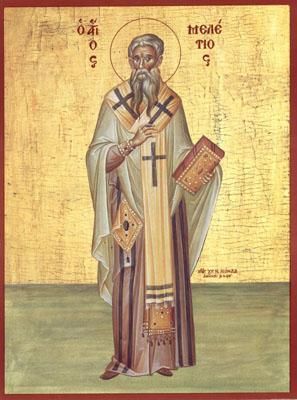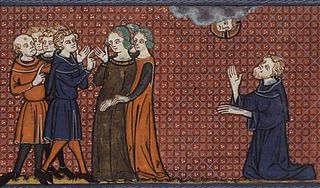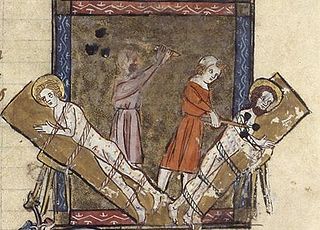Related Research Articles

Ambrogio Traversari, also referred to as Ambrose of Camaldoli, was an Italian monk and theologian who was a prime supporter of the papal cause in the 15th century. He is honored as a saint by the Camaldolese Order.

John Chrysostom was an important Early Church Father who served as Archbishop of Constantinople. He is known for his preaching and public speaking, his denunciation of abuse of authority by both ecclesiastical and political leaders, his Divine Liturgy of Saint John Chrysostom, and his ascetic sensibilities. The epithet Χρυσόστομος means "golden-mouthed" in Greek and denotes his celebrated eloquence. Chrysostom was among the most prolific authors in the early Christian Church.

Saint Meletius was a Christian bishop of Antioch from 360 until his death in 381. However, his episcopate was dominated by a schism, usually called the Meletian schism.

Proclus was the archbishop of Constantinople from 434 until his death. Renowned for his homiletic abilities, Proclus played a central role in the Nestorian controversy. His contributions to the theology of the developing cult of the Virgin Mary place him among the early and foremost Marian theologians. He is venerated as a saint in the Catholic Church, the Eastern Catholic Churches, the Eastern Orthodox Church, and Oriental Orthodoxy.

Theodore of Mopsuestia was a Christian theologian, and Bishop of Mopsuestia from 392 to 428 AD. He is also known as Theodore of Antioch, from the place of his birth and presbyterate. He is the best known representative of the middle Antioch School of hermeneutics.

Isaac or Sahak of Armenia was the catholicos of the Armenian Church from c. 387 until c. 438. He is sometimes known as Isaac the Great or Sahak the Parthian in reference to his father's Parthian origin. He was the last Armenian patriarch who was directly descended from Gregory the Illuminator, who converted the Kingdom of Armenia to Christianity in the early fourth century and became the first head of the Armenian Church. He supported Mesrop Mashtots in the creation of the Armenian alphabet and personally participated in the translation of the Bible into Armenian.
The Council of Ariminum, also known as the Council of Rimini, was an early Christian church synod in Ariminum, modern-day Rimini, in 359. Called by Roman Emperor Constantius II to resolve the Arian controversy, the Council of Ariminum for western bishops paralleled the Council of Seleucia for eastern bishops.

Pelagia, distinguished as Pelagia of Antioch, Pelagia the Penitent, and Pelagia the Harlot, was a Christian saint and hermit in the 4th or 5th century. Her feast day was celebrated on 8 October, originally in common with Saints Pelagia the Virgin and Pelagia of Tarsus. Pelagia died as a result of extreme asceticism, which had emaciated her to the point she could no longer be recognized. According to Orthodox tradition, she was buried in her cell. Upon the discovery that the renowned monk had been a woman, the holy fathers tried to keep it a secret, but the gossip spread and her relics drew pilgrims from as far off as Jericho and the Jordan valley.

The Forty Martyrs of Sebaste or the Holy Forty were a group of Roman soldiers in the Legio XII Fulminata whose martyrdom in the year 320 AD for the Christian faith is recounted in traditional martyrologies.

Gervasius and Protasius are venerated as Christian martyrs, probably of the 2nd century. They are the patron saints of Milan and of haymakers and are invoked for the discovery of thieves. Their feast day in the Latin Rite of the Catholic Church is 19 June, the day marking the translation of their relics. In the Eastern Orthodox Church and in the Eastern Rites of the Catholic Church, their feast takes place on 14 October (O.S.)/24 October (N.S.), the traditional day of their death. In Christian iconography their emblems are the scourge, the club and the sword.

Philastrius Bishop of Brescia, was one of the bishops present at a synod held in Aquileia in 381.

February 15 - Eastern Orthodox liturgical calendar - February 17

The Diocese of Brescia is a Latin diocese of the Catholic Church in the ecclesiastical province of the Metropolitan Archdiocese of Milan, in Lombardy.

Chromatius was a bishop of Aquileia.

In Christianity, the translation of relics is the ceremonial removal of holy objects from one place to another. Usually only the movement of the remains of a saint's body would be treated so formally, with secondary relics such as items of clothing treated with less ceremony. Translations could be accompanied by many acts, including all-night vigils and processions, often involving entire communities.

Saint Gaudentius was a bishop of Novara, considered the first of that city. Tradition states that he was born to a pagan family at Ivrea, and was then converted to Christianity by Eusebius of Vercelli. Some sources say that Eusebius ordained Gaudentius a priest, and that Gaudentius was sent to Novara by Eusebius to assist a Christian priest named Laurence (Laurentius) there.

Vigilius of Trent is venerated as the patron saint and bishop of Trent. He should not be confused with the pope of the same name.

October 24 - Eastern Orthodox liturgical calendar - October 26

Gaudentius of Rimini was a bishop of Rimini, who is venerated as a martyred saint in the Catholic Church and Eastern Orthodox Church.

The Church Fathers, Early Church Fathers, Christian Fathers, or Fathers of the Church were ancient and influential Christian theologians and writers who established the intellectual and doctrinal foundations of Christianity. The historical period in which they worked became known as the Patristic Era and spans approximately from the late 1st to mid-8th centuries, flourishing in particular during the 4th and 5th centuries, when Christianity was in the process of establishing itself as the state church of the Roman Empire.
References
- 1 2 Lizzi, Rita (1990). "Ambrose's Contemporaries and the Christianization of Northern Italy". The Journal of Roman Studies. 80: 156–173. doi:10.2307/300285. ISSN 0075-4358.
- 1 2 3 4 5 6 7 8 9 10 11 CATHOLIC ENCYCLOPEDIA: St. Gaudentius
- 1 2 3 Patron Saints Index: Saint Gaudentius Archived 2008-04-20 at the Wayback Machine
- ↑ “From a letter of St. Chrysostom (Ep. clxxxiv) to Gaudentius it may be gathered that the two had met at Antioch.” http://www.newadvent.org/cathen/06393c.htm